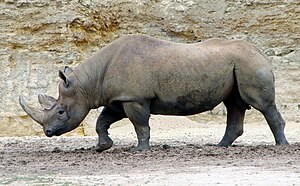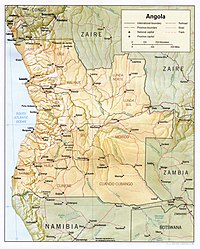Iona National Park
|
Parque Nacional de Iona
|
|
|
The black rhinoceros, one of the largest animals in Iona National Park |
|
| location | Angola , Circle Iona |
| surface | 15,150 km² |
| WDPA ID | 347 |
| Geographical location | 16 ° 40 ′ S , 12 ° 20 ′ E |
| Setup date | October 2, 1937 |
| administration | Direcção Nacional de Gestão do Ambiente , a department of the Ministério do Ambiente |
The Iona National Park (also Yona National Park , port .: Parque Nacional de lona ) is a national park in Angola . It covers most of the area of the parish of Iona . It is part of the Iona-Skeleton Coast cross-border park in the territories of Angola and Namibia .
At 15,150 km², the Iona National Park is the largest of the six national parks in Angola , ahead of the Kameia National Park and the famous Kissama National Park .
geography
The national park is characterized by its various savannah landscapes and towards the Atlantic by its dune landscape , with the Welwitschia that can often be found here, up to 1000 years old . The large mammals in the park include a. Elephants , lions , black rhinos , leopards , hyenas , the gauntlet , greater kudu and zebra species . The national animal of Angola, the Palanca Negra Gigante , was also considered native here, but is probably already extinct here.
Like all national parks in Angola, the Iona National Park is subordinate to the Direcção Nacional de Gestão do Ambiente (German: "National Administrative Directorate for Environmental Issues"), a department within the Ministry of the Environment ( Ministério do Ambiente ).
history
The Iona National Park was founded by the Portuguese Colonial Administration on October 2, 1937 as a protected hunting district ( Portuguese : Reserva de caça ) and has been classified as a national park since December 26, 1964 .
In the course of the Angolan civil war (1975-2002) the management in the park was severely neglected. Since the peace treaty in 2002 and the government's subsequent reconstruction programs, nature conservation and thus also the national parks have again been in the focus of those responsible, according to the Angolan Narchtrenagentur.
In autumn 2013, the park's staff and equipment were increased significantly, and further training measures were agreed in cooperation with South Africa . The technical equipment of the staff with vehicles and means of communication improved. This should also make the fight against poachers much more effective. At the same time, a US $ 10.5 million program for six years to renew the park's facilities and fences and improve its administration and data processing was agreed, funded by the Government of Angola, the European Union , and the United Nations Development Program Nations . As a result, the park's tourist offers , which have been in existence since 2001, are also expected to gain in importance.
Web links
- World Database on Protected Areas - Iona National Park (English)
- Profile of the Iona National Park on the Angolan environmental blog Ecoharia (port.)
Individual evidence
- ↑ a b Article from May 17, 2014 on the decline in poaching in the Cameia National Park with the ongoing disarmament after the civil war , state news agency ANGOP , accessed on May 29, 2014.
- ^ Iona National Park profile on Angola's National Parks website , accessed May 29, 2014.
- ↑ Article of September 26, 2013 about material and personnel improvements in the Iona National Park , state news agency ANGOP, accessed on May 29, 2014.
- ↑ Article from September 2, 2013 on www.verangola.net, accessed on May 29, 2014.



